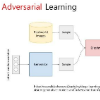Liver segmentation on images acquired using computed tomography (CT) and magnetic resonance imaging (MRI) plays an important role in clinical management of liver diseases. Compared to MRI, CT images of liver are more abundant and readily available. However, MRI can provide richer quantitative information of the liver compared to CT. Thus, it is desirable to achieve unsupervised domain adaptation for transferring the learned knowledge from the source domain containing labeled CT images to the target domain containing unlabeled MR images. In this work, we report a novel unsupervised domain adaptation framework for cross-modality liver segmentation via joint adversarial learning and self-learning. We propose joint semantic-aware and shape-entropy-aware adversarial learning with post-situ identification manner to implicitly align the distribution of task-related features extracted from the target domain with those from the source domain. In proposed framework, a network is trained with the above two adversarial losses in an unsupervised manner, and then a mean completer of pseudo-label generation is employed to produce pseudo-labels to train the next network (desired model). Additionally, semantic-aware adversarial learning and two self-learning methods, including pixel-adaptive mask refinement and student-to-partner learning, are proposed to train the desired model. To improve the robustness of the desired model, a low-signal augmentation function is proposed to transform MRI images as the input of the desired model to handle hard samples. Using the public data sets, our experiments demonstrated the proposed unsupervised domain adaptation framework outperformed four supervised learning methods with a Dice score 0.912 plus or minus 0.037 (mean plus or minus standard deviation).
翻译:使用计算断层成像和磁共振成像(MRI)获得的图像的利谱分解在肝病临床管理中发挥重要作用。 与MRI相比, 肝脏的CT图像更丰富, 更容易获得。 但是, MRI可以提供更丰富的肝脏定量信息, 与CT相比。 因此, 可取的做法是实现不受监督的域适应, 将从源域获得的含有标签的CT图像的知识传输到包含未标记的 MR 图像的目标域。 在这项工作中, 我们通过联合对称学习和自我学习, 报告了用于跨模式肝脏分解的新而不受监督的域域域调整框架。 我们建议采用联合对称学习和对称, 联合对称- 肝脏和对称- 对称- 对称- 对称的对立图像转换框架, 将从目标域域中提取的任务相关特性的分布与源域域域的对等。 在拟议模型中, 以未加标的 M- 对称模式的对称模式损失进行培训, 然后将伪- 模拟- 对等- 对等- 对等- 对等- 对等- 对等- 对等- 对等- 对等- 对等- 对等- 对等- 对等- 对等- 对等- 对等- 对等- 对等- 对等- 对等- 对等- 对等- 对等- 对等- 对等- 对等- 对等- 对等- 对等- 对等- 对等- 对等- 对等- 对等- 对等- 对等- 对等- 对等- 对等- 对等- 对等- 对等- 对等- 对等- 对等- 对等- 对等- 对等- 对等- 对等- 对等- 对等- 对等- 对等- 对等- 对等- 对等- 对等- 对等- 对等- 对等- 对等- 对等- 对等- 对等- 对等-对等-对等- 对等- 对等- 对等- 对等-对等- 对等- 对等- 对等- 对等- 对等- 对等- 对等- 对等- 对等- 对等- 对等- 对等- 对等-对等-对等-对等-对等-对等-对等-对



